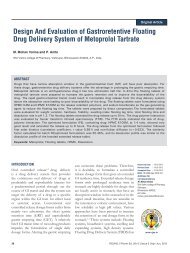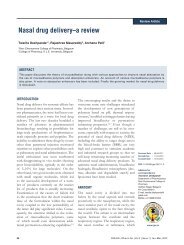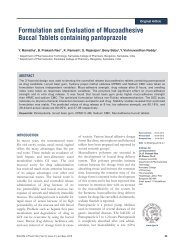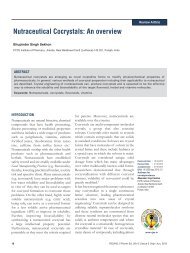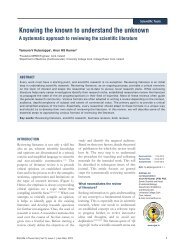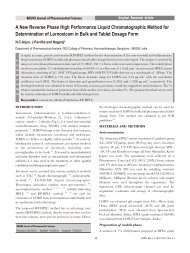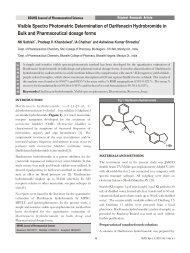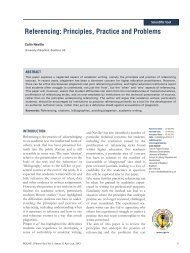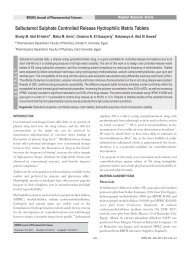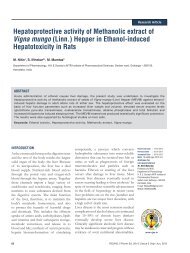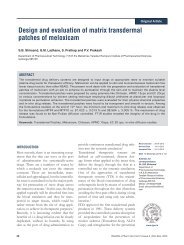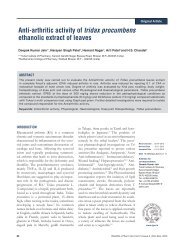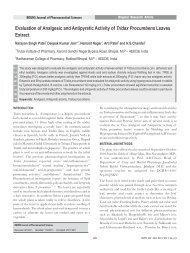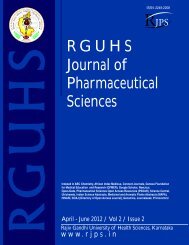Chitosan Loaded Mucoadhesive Microspheres of Gliclazide - Journal
Chitosan Loaded Mucoadhesive Microspheres of Gliclazide - Journal
Chitosan Loaded Mucoadhesive Microspheres of Gliclazide - Journal
Create successful ePaper yourself
Turn your PDF publications into a flip-book with our unique Google optimized e-Paper software.
Prakash Rao B et al./ Formulation and Evaluation <strong>of</strong> <strong>Mucoadhesive</strong> Buccal Drug Delivery System <strong>of</strong> Metoprolol Tartrate by Using Central Composite Design<br />
Higuchi Release Model<br />
To study the Higuchi release model the release rate data are<br />
fitted into the following equation:<br />
½<br />
Q = K H t (4)<br />
Where, 'Q' is the fraction <strong>of</strong> drug release, 'KH' is the release<br />
rate constant and't' is the release time. The graph is plotted %<br />
CDR verses square root <strong>of</strong> time.<br />
Korsmeyer and Peppas Kinetics<br />
To study the Korsmeyer and Peppas release kinetics the<br />
release rate data are fitted in to following equation:<br />
n<br />
Mt/M∞ = K KP t (5)<br />
Where, Mt/M∞ is the fraction <strong>of</strong> drug release, 'K ' is the<br />
KP<br />
release rate constant and 't' is the release time and 'n' is the<br />
diffusion exponent related to mechanism <strong>of</strong> drug release. The<br />
graph is plotted log %CDR verses log time.<br />
Fourier Transform Infrared Spectroscopy (FT-IR)<br />
IR spectroscopy was carried out for the following A) Pure<br />
drug, B) Drug + carbopol C) Drug + HPC using Shimadzu<br />
FTIR model 8700by taking KBr disc. The instrument was<br />
operated under dry air purge and the scans were collected at<br />
-1<br />
scanning speed <strong>of</strong> 2mm\sec with resolution <strong>of</strong> 4cm over the<br />
-1 18<br />
region <strong>of</strong> 4000-400 cm .<br />
Differential Thermal Analysis (DTA)<br />
The sample <strong>of</strong> MT, carbopol, HPC and their binary mixtures<br />
were weighed and sealed in 40 ml aluminum crucibles with a<br />
pierced aluminum lid. The analyses were performed under<br />
nitrogen (nitrogen flow rate 50 ml/min) in order to eliminate<br />
oxidative and pyrrolytic effects at a standard heating rate <strong>of</strong><br />
15ºC/minute over a temperature range <strong>of</strong> 30ºC - 300ºC using<br />
a Mettler-Toledo star system.<br />
Stability studies<br />
An accelerated stability study was carried out according to<br />
ICH guidelines. The optimized formulation was kept in 2 ml<br />
0<br />
<strong>of</strong> glass vial and closed. The vials were kept at 40 ± 2 C / 75<br />
RH ± 5% RH for six months in a dessicator. After end <strong>of</strong><br />
every month, tablets were evaluated for bioadhesive strength<br />
and drug content.<br />
RESULTS AND DISCUSSION<br />
Development <strong>of</strong> Formulations<br />
Evaluation <strong>of</strong> Tablets<br />
The average thickness <strong>of</strong> the all buccal tablets ranges from<br />
2.12 to 3.25 mm. The value <strong>of</strong> percentage variation in weight<br />
and friability were found to be with in the limit <strong>of</strong><br />
149<br />
conventional oral tablets stated in the Indian pharmacopeia.<br />
Hardness <strong>of</strong> all buccal tablets was higher because <strong>of</strong> the<br />
carbopol. In all the formulations, the assay for drug content<br />
was found to be in the range from 47.56 mg to 49.65 mg.<br />
In-vitro drug release study after 8 hour<br />
Total amount <strong>of</strong> metoprolol tartrate released from all<br />
formulations ranges from 60.45% to 87.90% in 8 hours (Table<br />
3). Decreased rate <strong>of</strong> drug release was observed with increase<br />
<strong>of</strong> the concentration <strong>of</strong> polymers. (Fig. 2-4) illustrates the<br />
release pr<strong>of</strong>ile <strong>of</strong> all formulations. When the tablets contact<br />
Fig. 2: In-vitro drug release pr<strong>of</strong>iles <strong>of</strong> formulation F-1 to F-5<br />
Fig. 3: In-vitro drug release pr<strong>of</strong>iles <strong>of</strong> formulation F-6 to F-9<br />
Fig. 4: In- vitro drug release pr<strong>of</strong>iles <strong>of</strong> formulation F-10 to F-13<br />
RJPS, Jul - Sep, 2011/ Vol 1/ Issue 2



